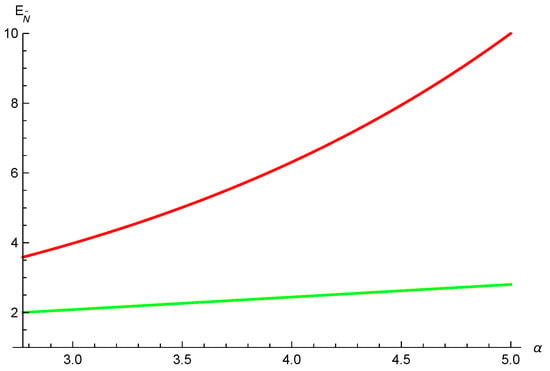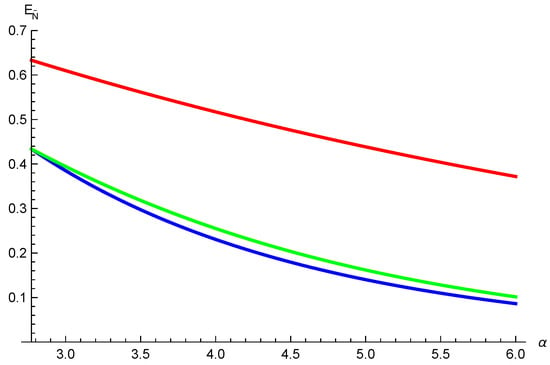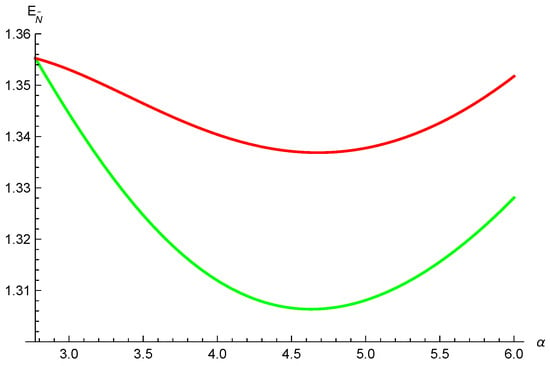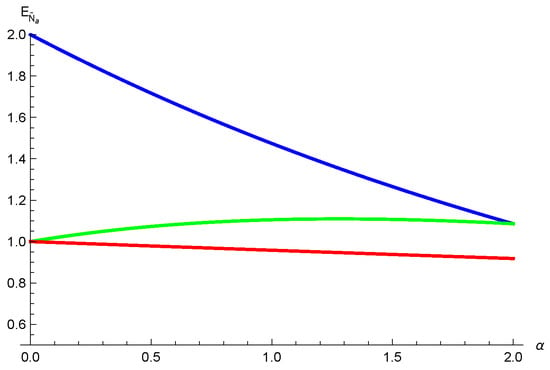Abstract
The monogamy property of entanglement is an intriguing feature of multipartite quantum entanglement. Most entanglement measures satisfying the monogamy inequality have turned out to be convex. Whether nonconvex entanglement measures obey the monogamy inequalities remains less known at present. As a well-known measure of entanglement, the logarithmic negativity is not convex. We elucidate the constraints of multi-qubit entanglement based on the logarithmic convex-roof extended negativity (LCREN) and the logarithmic convex-roof extended negativity of assistance (LCRENoA). Using the Hamming weight derived from the binary vector associated with the distribution of subsystems, we establish monogamy inequalities for multi-qubit entanglement in terms of the th-power () of LCREN, and polygamy inequalities utilizing the th-power () of LCRENoA. We demonstrate that these inequalities give rise to tighter constraints than the existing ones. Furthermore, our monogamy inequalities are shown to remain valid for the high-dimensional states that violate the CKW monogamy inequality. Detailed examples are presented to illustrate the effectiveness of our results in characterizing the multipartite entanglement distributions.
1. Introduction
Quantum entanglement is vital in quantum mechanics, offering profound insights into the essence of quantum correlations and serving pivotal functions in quantum information processing. As the key resource in quantum tasks, quantum entanglement has been used in many quantum communication protocols such as superdense coding [1], quantum cryptography [2], quantum teleportation [3] and remote-state preparation [4]. One remarkable feature of quantum entanglement, setting it apart from classical correlations, is its inherent limitation in being shared among multipartite quantum systems, referred to as the monogamy of entanglement (MoE) [5,6]. MoE’s restrictions on the information accessible to potential eavesdroppers regarding secret key extraction play a pivotal role in the security of many information-theoretic protocols such as quantum key distribution [7,8,9]. MoE has been widely used in many areas of physics such as condensed-matter physics [10] and even black-hole physics [11]. MoE may also help to investigate the efficiency of entanglement used in quantum cryptography and in characterizations of the entanglement distributions.
Coffman, Kundu and Wootters (CKW) firstly characterized the monogamy of entanglement for three-qubit states ,
where and are the reduced density matrices by tracing over the subsystem C and B, respectively, with () denoting the partial trace with respect to the subsystem B (C). is the tangle of between subsystems A and , and () is the tangle between A and B (A and C) [12]. The CKW inequality illustrates the incompatibility of the two-qubit entanglement between and . Thus, the sum of the entanglement of the two-qubit systems cannot surpass the collective entanglement between A and . The CKW inequality was expanded to encompass different measures of bipartite entanglement, enabling its extension to multi-qubit systems [13] and higher-dimensional quantum systems [14,15,16,17].
The entanglement of assistance, as a complementary quantity to bipartite entanglement, holds immense significance too. It notably displays a dualistic monogamous nature within multi-qubit quantum systems and gives rise to polygamous relationships. Whereas MoE inequalities provide upper bounds on the shareability of entanglement among quantum subsystems, the authors in Ref. [18] prove that this bound also acts as a lower bound (conjectured in Ref. [19]) for the distribution of entanglement, the entanglement of assistance, to a target pair of A and B [20,21,22]. This distribution of entanglement is established by performing collective operations on the rest of the subsystems so as to maximize the shared entanglement between A and B. The duality of entanglement shareability versus entanglement of assistance is evident in that the upper bound for the former is the lower bound for the latter. For a three-qubit state , the polygamy inequality is defined by
where is the tangle of assistance [18,19]. The polygamy inequality was extended to encompass multi-qubit systems and certain classes of higher-dimensional quantum systems by using diverse entropic entanglement measures [16,23,24,25,26].
Lately, there have been noteworthy discussions on monogamy and polygamy inequalities based on the th-power of entanglement measures [27,28,29]. In Ref. [30], Kim derived strict monogamy inequalities by using the Hamming weight. This approach effectively captures the entangled nature of quantum states and offers a novel study of monogamy. Subsequently, comprehensive sets of inequalities associated with the Hamming weight of entanglement measures have been introduced [31,32].
It is generally acknowledged that monogamy inequalities are consistently fulfilled by entanglement measures exhibiting convexity. The question of whether a nonconvex measure of entanglement abides by the monogamy inequality remains less known presently. The nonconvex nature of the logarithmic negativity is surprising, as it is generally considered that convexity describes the local physical process of losing information [33,34]. However, it should be noted that the convexity is primarily a mathematical requirement for entanglement monotones and does not necessarily describe a physical process that involves the loss of information about a quantum system [34]. Indeed, it is the combination of concavity and the monotonicity of the logarithm that allows for the proof of the nonincreasing of the logarithmic negativity under positive partial transpose (PPT)-preserving operations [34]. In addition, the logarithmic negativity, which possesses an operational interpretation, is an entanglement monotone under both general local operations and classical communication (LOCC) [35]. The measure is the upper bound on distillable entanglement [34,35] and is related to the entanglement cost under PPT-preserving operations [35]. Therefore, complementary to those of the convex measures of entanglement, the monogamy of logarithmic negativity is a key issue in the theory of quantum entanglement.
In this paper, we offer a more detailed characterization of multi-qubit entanglement by using these nonconvex entanglement measures. Our research reveals that the monogamy and polygamy inequalities we present are upheld in a tighter way compared to those elucidated in Ref. [36]. Additionally, the newly proposed monogamy inequalities are shown to be more effective in addressing counterexamples raised by the CKW monogamy inequality in higher-dimensional systems.
2. Preliminaries
Let us first review the conceptions of LCREN and LCRENoA, as well as the monogamy and polygamy inequalities associated with them in multi-qubit systems. For a quantum state on Hilbert space , the negativity is defined as [33,34,37]
where denotes the partial transpose of with respect to the subsystem A, and the trace norm of any X is defined by . The logarithmic negativity is defined as [33,34],
This measure serves as an entanglement monotone under both general local operation and classical communication (LOCC), as well as positive partial transpose (PPT)-preserving operations. It is also additive in nature but lacks convexity [34].
The convex-roof extended negativity (CREN) of a bipartite state is defined by [38],
and the CREN of assistance (CRENoA) is defined by [14],
where the minimum and maximum are taken over all possible pure-state decompositions of with , and . By definition, both CREN and CRENoA of a pure state are equal to the negativity.
For any bipartite state , the LCREN is defined by
LCREN is a bona fide measure of entanglement. It exhibits both a nonincrease under LOCC and an average nonincrease under LOCC, which can be attributed to CREN’s entanglement monotonicity, logarithmic monotonicity and logarithm concavity. Nonetheless, similar to the logarithmic negativity, LCREN lacks convexity.
For any -qubit state , a monogamy inequality has been presented in Ref. [36] for ,
where is the LCREN of with respect to the bipartition A and , and is the LCREN of the reduced density matrix , .
Similar to LCREN, the LCRENoA is defined by
For , we obtain the polygamy inequality [36],
where is the LCRENoA of with respect to the bipartition A and , and is the LCRENoA of the reduced density matrices , .
The tighter monogamy relations give rise to a more refined characterization of the entanglement distributions among the quantum systems, and significant applications such as in the security of quantum cryptographic protocols based on entanglement by limiting eavesdropper correlations with the honest parties. Therefore, new tighter monogamy relations of entanglement provide better understanding and applications of quantum entanglement. In the forthcoming sections, we present improvements to the above inequalities, achieving significantly tighter constraints on multi-qubit entanglement distribution under specific conditions.
3. Tighter Monogamy Inequalities of Multi-Qubit LCREN
We first present a series of notations and definitions to assist in understanding the subsequent discussion. For any nonnegative integer j with binary expansion , where and for , one defines a unique binary vector associated with j, . The Hamming weight of the binary vector is defined as the number of in its coordinates [39]. Moreover, the Hamming weight is bounded above by ,
We also require the subsequent lemma, which can be easily verified.
Lemma 1.
For and nonnegative real number α, we have
for , and
for .
In the subsequent discussion, we present a new class of monogamy relations in terms of the th-power of LCREN by incorporating the concept of Hamming weight.
Theorem 1.
For any -qubit state , we have
where , is the vector from the binary representation of j, and is the Hamming weight of .
Proof.
From inequality (3), one has . Thus, it is sufficient to show that
We can assume, without loss of generality, that the qubit subsystems are appropriately labeled such that
for .
Initially, we demonstrate the validity of inequality (10) for the case of . For , we obtain
Therefore, inequality (10) holds for .
Assuming the validity of inequality (10) for (where ), we now proceed to prove its applicability to the case of . For an -qubit state with its two-qubit reduced density matrices with , we have
Inequality (11) implies that
According to the induction hypothesis, we obtain
By relabeling the subsystems, the induction hypothesis leads to
Therefore, we have
Considering the existence of a positive integer N satisfying the condition . Let us now contemplate a pure state consisting of qubits, ; the state can be precisely expressed as the tensor product of and , where represents an arbitrary -qubit state. We have
where denotes the two-qubit reduced density matrix derived from , . Therefore,
where denotes the state under bipartition and , , for , and for each , which completes the proof. □
Remark 1.
Since for any , for any -qubit state , we can express it using the following relation,
Example 1.
In the generalized Schmidt decomposition, the three-qubit state can be expressed as [38,40],
where , , and . One obtains , and . Setting , and , we have , and . Using relation (2) we have , and . Thus, from our result (9), and from the result (3) given in Ref. [36]. One can see our inequality (9) is tighter than the result (3) in Ref. [36] for , see Figure 1.
Inequality (9) can be further enhanced under specific circumstances, resulting in a significantly tightened form.
Theorem 2.
For , any -qubit state satisfies
if
for .
Proof.
From inequality (3), we only need to prove
Here, we employ mathematical induction on N. It becomes evident that inequality (17) is valid for , as derived from (9), assuming its validity for all positive integers smaller than N. Since , we have
where the first inequality stems from Lemma 1, and the subsequent inequality relies on the induction hypothesis. □
Remark 2.
According to (6), for any one has
Example 2.
Let us consider the four-qubit entangled decoherence-free state [41], , where are logic basis states given by
We can also use the different examples to show that inequality (16) is better than inequality (9) for .
Example 3.
The conditions (17) are not universally fulfilled; we derive the subsequent monogamy inequality under alternate circumstances.
Theorem 3.
For , any -qubit state satisfies
on the condition that for , and for , , .
Proof.
From Theorem 1 for the case , we have
Since for , using Theorem 1 again, we have
Remark 3.
From Theorem 3, if for all , one has
4. Tighter Polygamy Inequalities of Multi-Qubit LCRENoA
Here, we present refined polygamy inequalities by utilizing the th-power of LCRENoA.
Theorem 4.
For any -qubit state , we have
where , is the vector from the binary representation of j, and is the Hamming weight of .
Proof.
From inequality (5), one has . Thus, it is sufficient to show that
Assuming no loss of generality, we label the qubit subsystems in a manner that preserves their intended order such that
for .
Firstly, we demonstrate the validity of inequality (24) for the case of . For , we obtain
Therefore, inequality (24) holds for .
Taking into consideration that inequality (24) has already been established for the case where , with , we now proceed to demonstrate its validity for the case of , and we have
Because of the ordering of subsystems, inequality (25) implies
By the induction hypothesis, we obtain
Through the process of reassigning labels to the subsystems, the induction hypothesis offers the following outcome,
Thus, we have
Now, consider a -qubit state . We have
Therefore,
where , for , and for each , which completes the proof. □
Remark 4.
Since for any , for any -qubit state , we have the following relation
Example 4.
Let us consider the 3-qubit generalized W state,
Just as the transition from inequality (9) to inequality (16), we can likewise enhance the polygamy inequality in Theorem 4. The proof is similar to Theorem 2.
Theorem 5.
For , any -qubit state satisfies
if
for .
Remark 5.
In fact, according to relation (6), for any , one has
Example 5.
By modifying the conditions stated in Theorem 5, we are able to present more comprehensive results.
Theorem 6.
For , any -qubit state satisfies
on the condition that for and for , , .
Remark 6.
From Theorem 6, if for all , we have
5. Conclusions and Discussions
Monogamy and polygamy relations exemplify the fundamental properties displayed in multi-qubit entanglement, exhibiting the intricate nature of quantum entanglement. We elucidated the manifestations of multi-qubit monogamy and polygamy constraints by utilizing the nonconvex entanglement measures LCREN and LCRENoA. We integrated the Hamming weight and the LCREN (LCRENoA) for the first time, and presented new classes of monogamy and polygamy relations. We also demonstrated that these new inequalities impose finer constraints than the previous ones. Our approaches may be used in future studies aimed at comprehending the entanglement distribution in multi-qubit systems.
We focused on multi-qubit systems. It is noteworthy that our tight monogamy inequality (9) remains applicable not only to such systems but also to certain higher-dimensional quantum systems for which the CKW monogamy inequality (1) is violated. First, let us recall the definition of tangle. The tangle of a bipartite pure state is defined as , where [12]. The tangle of a bipartite mixed state is defined by [12]
where the minimization is taken over all possible pure-state decompositions of with , and . For multi-qubit states, the tangle satisfies the following monogamy inequality,
Nevertheless, the monogamy inequality (30) based on the tangle does not generally hold for systems with higher dimensions [14,42,43]. Specifically, one can readily confirm that the following three-qutrit state violates the inequality (30),
In addition, the following state also violates the inequality (30),
Concerning our LCREN-based monogamy inequality (9) for the quantum state (31), we have and . Using relation (2), we have and . Thus, we have
for . Namely, our monogamy inequality (9) still holds for state (31), see Figure 6.

Figure 6.
The red line is the exact value of . The green line represents the lower bound from our results (9).
Likewise, considering the quantum state (32), we have and . Using relation (2), we have and . Thus, we have
for . In other words, The LCREN-based monogamy inequality (9) remains applicable to high-dimensional states that violate the CKW monogamy inequality (1). Our discoveries may shed light on further investigations on entanglement distribution in high-dimensional systems.
Author Contributions
Writing—original draft, Z.S., D.X. and W.Z.; writing—review and editing, Z.W. and S.-M.F. All authors have read and agreed to the published version of the manuscript.
Funding
This work is supported by the National Natural Science Foundation of China (NSFC) under Grants 12075159 and 12171044, and the Academician Innovation Platform of Hainan Province.
Data Availability Statement
All data generated or analyzed during this study are included and cited in this article.
Conflicts of Interest
The authors declare no conflicts of interest.
References
- Bennett, C.H.; Wiesner, S.J. Communication via one- and two-particle operators on Einstein-Podolsky-Rosen states. Phys. Rev. Lett. 1992, 69, 2881. [Google Scholar] [CrossRef]
- Groblacher, S.; Jennewein, T.; Vaziri, A.; Weihs, G.; Zeilinger, A. Experimental quantum cryptography with qutrits. New J. Phys. 2006, 8, 75. [Google Scholar] [CrossRef]
- Bennett, C.H.; Brassard, G.; Crepeau, C.; Jozsa, R.; Peres, A.; Wootters, W.K. Teleporting an unknown quantum state via dual classical and Einstein-Podolsky-Rosen channels. Phys. Rev. Lett. 1993, 70, 1895. [Google Scholar] [CrossRef]
- Pati, A.K. Minimum classical bit for remote preparation and measurement of a qubit. Phys. Rev. A 2000, 63, 014302. [Google Scholar] [CrossRef]
- Terhal, B.M. Is entanglement monogamous? IBM Res. Dev. 2004, 48, 71. [Google Scholar] [CrossRef]
- Kim, J.S.; Gour, G.; Sanders, B.C. Limitations to sharing entanglement. Contemp. Phys. 2012, 53, 417. [Google Scholar] [CrossRef]
- Pawlowski, M. Security proof for cryptographic protocols based only on the monogamy of Bell’s inequality violations. Phys. Rev. A 2010, 82, 032313. [Google Scholar] [CrossRef]
- Acín, A.; Gisin, N.; Masanes, L. From Bell’s theorem to secure quantum key distribution. Phys. Rev. Lett. 2006, 97, 120405. [Google Scholar] [CrossRef] [PubMed]
- Tomamichel, M.; Fehr, S.; Kaniewski, J.; Wehner, S. A monogamy-of-entanglement game with applications to device-independent quantum cryptography. New J. Phys. 2013, 15, 103002. [Google Scholar] [CrossRef]
- Ma, X.S.; Dakic, B.; Naylor, W.; Zeilinger, A.; Walther, P. Quantum simulation of the wavefunction to probe frustrated Heisenberg spin systems. Nat. Phys. 2011, 7, 399. [Google Scholar] [CrossRef]
- Verlinde, E.; Verlinde, H. Black hole entanglement and quantum error correction. J. High Energy Phys. 2013, 1310, 107. [Google Scholar] [CrossRef]
- Coffman, V.; Kundu, J.; Wootters, W.K. Distributed entanglement. Phys. Rev. A 2000, 61, 052306. [Google Scholar] [CrossRef]
- Osborne, T.; Verstraete, F. General Monogamy Inequality for Bipartite Qubit Entanglement. Phys. Rev. Lett. 2006, 96, 220503. [Google Scholar] [CrossRef] [PubMed]
- Kim, J.S.; Das, A.; Sanders, B.C. Entanglement monogamy of multipartite higher-dimensional quantum systems using convex-roof extended negativity. Phys. Rev. A 2009, 79, 012329. [Google Scholar] [CrossRef]
- Kim, J.S.; Sanders, B.C. Monogamy of multi-qubit entanglement using Rényi entropy. J. Phys. A Math. Theor. 2010, 43, 445305. [Google Scholar] [CrossRef]
- Kim, J.S. Tsallis entropy and entanglement constraints in multiqubit systems. Phys. Rev. A 2010, 81, 062328. [Google Scholar] [CrossRef]
- Kim, J.S.; Sanders, B.C. Unified entropy, entanglement measures and monogamy of multi-party entanglement. J. Phys. A Math. Theor. 2011, 44, 295303. [Google Scholar] [CrossRef]
- Gour, G.; Bandyopadhay, S.; Sanders, B.C. Dual monogamy inequality for entanglement. J. Math. Phys. 2007, 48, 012108. [Google Scholar] [CrossRef]
- Gour, G.; Meyer, D.A.; Sanders, B.C. Deterministic entanglement of assistance and monogamy constraints. Phys. Rev. A 2005, 72, 042329. [Google Scholar] [CrossRef]
- DiVincenzo, D.P. The Entanglement of Assistance, Lecture Notes in Computer Science; Springer: Berlin, Germany, 1999; Volume 1509, pp. 247–257. [Google Scholar]
- Cohen, O. Unlocking Hidden Entanglement with Classical Information. Phys. Rev. Lett. 1998, 80, 2493. [Google Scholar] [CrossRef]
- Laustsen, T.; Verstraete, F.; van Enk, S.J. Local vs. Joint Measurements for the Entanglement of Assistance. Quantum Inf. Comput. 2003, 3, 64. [Google Scholar] [CrossRef]
- Buscemi, F.; Gour, G.; Kim, J.S. Polygamy of distributed entanglement. Phys. Rev. A 2009, 80, 012324. [Google Scholar] [CrossRef]
- Kim, J.S. Unification of multiqubit polygamy inequalities. Phys. Rev. A 2012, 85, 032335. [Google Scholar] [CrossRef]
- Kim, J.S. General polygamy inequality of multiparty quantum entanglement. Phys. Rev. A 2012, 85, 062302. [Google Scholar] [CrossRef]
- Kim, J.S. Tsallis entropy and general polygamy of multiparty quantum entanglement in arbitrary dimensions. Phys. Rev. A 2016, 94, 062338. [Google Scholar] [CrossRef]
- Zhu, X.N.; Fei, S.M. Entanglement monogamy relations of qubit systems. Phys. Rev. A 2014, 90, 024304. [Google Scholar] [CrossRef]
- Jin, Z.X.; Fei, S.M. Tighter entanglement monogamy relations of qubit systems. Quantum Inf. Process. 2017, 16, 77. [Google Scholar] [CrossRef]
- Kim, J.S. Negativity and tight constraints of multiqubit entanglement. Phys. Rev. A 2018, 97, 012334. [Google Scholar] [CrossRef]
- Kim, J.S. Hamming weight and tight constraints of multi-qubit entanglement in terms of unified entropy. Sci. Rep. 2018, 8, 12245. [Google Scholar] [CrossRef]
- Yang, L.M.; Chen, B.; Fei, S.M.; Wang, Z.X. Tighter constraints of multiqubit entanglement for negativity. Quantum Inf. Process. 2020, 19, 4. [Google Scholar] [CrossRef]
- Guo, M.L.; Li, B.; Wang, Z.X.; Fei, S.M. Tighter constraints of multiqubit entanglement in terms of Rényi-α entropy. Chin. Phys. B 2020, 29, 070304. [Google Scholar] [CrossRef]
- Vidal, G.; Werner, R.F. Computable measure of entanglement. Phys. Rev. A 2002, 65, 032314. [Google Scholar] [CrossRef]
- Plenio, M.B. Logarithmic Negativity: A Full Entanglement Monotone That is not Convex. Phys. Rev. Lett. 2005, 95, 090503. [Google Scholar] [CrossRef]
- Audenaert, K.; Plenio, M.B.; Eisert, J. Entanglement cost under positive-partial-transpose-preserving operations. Phys. Rev. Lett. 2003, 90, 027901. [Google Scholar] [CrossRef]
- Gao, L.M.; Yan, F.L.; Gao, T. Monogamy of nonconvex entanglement measures. Results Phys. 2021, 31, 104983. [Google Scholar] [CrossRef]
- Życzkowski, K.; Horodecki, P.; Sanpera, A.; Lewenstein, M. Volume of the set of separable states. Phys. Rev. A 1998, 58, 883. [Google Scholar] [CrossRef]
- Acin, A.; Andrianov, A.; Costa, L.; Jané, E.; Latorre, J.I.; Tarrach, R. Generalized Schmidt Decomposition and Classification of Three-Quantum-Bit States. Phys. Rev. Lett. 2003, 85, 1560. [Google Scholar] [CrossRef] [PubMed]
- Nielsen, M.A.; Chuang, I.L. Computation and Quantum Information; Canbrudge University Press: Cambridge, UK, 2000; pp. 60–169. [Google Scholar]
- Gao, X.H.; Fei, S.M. Estimation of concurrence for multipartite mixed states. Eur. Phys. J. Spec. Topics 2008, 159, 71. [Google Scholar] [CrossRef]
- Zhou, Y.S.; Li, X.; Deng, Y.; Li, H.R.; Luo, M.X. Generation of hybrid four-qubit entangled decoherence-free states assisted by the cavity-QED system. Opt. Commun. 2015, 366, 397. [Google Scholar] [CrossRef]
- Ou, Y.C. Violation of monogamy inequality for higher-dimensional objects. Phys. Rev. A 2007, 75, 034305. [Google Scholar] [CrossRef]
- Kim, J.S.; Sanders, B.C. Generalized W-class state and its monogamy relation. J. Phys. A Math. Theor. 2008, 41, 495301. [Google Scholar] [CrossRef]
Disclaimer/Publisher’s Note: The statements, opinions and data contained in all publications are solely those of the individual author(s) and contributor(s) and not of MDPI and/or the editor(s). MDPI and/or the editor(s) disclaim responsibility for any injury to people or property resulting from any ideas, methods, instructions or products referred to in the content. |
© 2024 by the authors. Licensee MDPI, Basel, Switzerland. This article is an open access article distributed under the terms and conditions of the Creative Commons Attribution (CC BY) license (https://creativecommons.org/licenses/by/4.0/).




